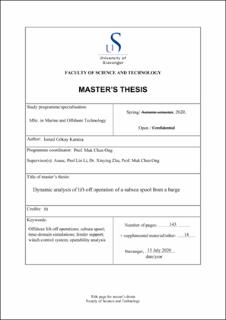| dc.description.abstract | The lift-off operation faces great operational challenges due to the harsh environment in the North Sea. Especially, the operation becomes more susceptible to environmental conditions when the installation method involves two floating vessels. A combination of dynamic responses, such as environmental conditions, operational procedures and human error, makes lift-off operations challenging and risky. Therefore, the planning of such operation requires careful numerical studies of the installation method in order to execute the operations safely. The spool is a commonly used subsea structure in the offshore fields and is mostly installed by a lifting vessel, but there is a little work focusing on the installation method involving a transportation barge and a lifting vessel together. Thus, accurate numerical models and methods are required to predict the responses of the lifting system.
This thesis addresses the numerical analysis of the lift-off operation of a large subsea spool from a transportation barge. Numerical modelling of the lift-off is comprising a lifting vessel, a transportation barge, a spool, and coupling elements such as fender and wire couplings. Time-domain simulations are performed to capture nonlinear dynamic responses during the lift-off operations under various irregular waves. A systematic approach is used to assess allowable sea states. Based on the recommended practice, the critical events are potential snap loads, slack wire condition in slings and re-hit force between the spool and the transportation barge. Among these criteria, the dominant criterion is the re-hit force due to the large size of the spool. Therefore, it requires examining the potential increase of response-based operational limits by two methods. The first method is using different support models between the barge and the spool, and the second method is developing a new method to find best lift-off instance.
In the first method, different fender supports have been modelled, and the critical fender forces are compared to assess the potential improvement of the sea states. It has resulted in the understanding that the allowable sea state can be increased significantly by properly choosing the fender support structure. In the second method, a control method is developed to find a proper lift-off instance to start the winch. The dynamic response between the crane tip and the transportation barge plays a significant role in the initial motion of the lift-off. Therefore, the control method involves the estimation of future relative motions. Different sensitivity studies are carried out with the control method to assess the allowable sea states. The purpose of these sensitivity studies is to define the optimum algorithm for different peak periods.
An increase sea states also indicate the significant potential of increasing the operability of lift-off operation. Therefore, the allowable sea states assessed from these methods will be used as an input of the operability analysis in order to assess of the effect of the different methods. The main objective is to define the most optimum installation method in terms of numbers of spools, and the transportation time. The sensitivity studies are concluded with increased operability by the fender models and the control method. | en_US |
